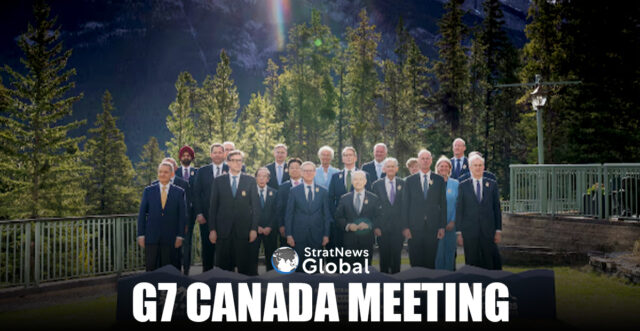Finance leaders from the Group of Seven (G7) industrialised democracies worked on Wednesday to ease tensions over United States President Donald Trump’s tariff policies and to find shared ground aimed at preserving the relevance and effectiveness of the forum, as they gathered for talks in the Canadian Rocky Mountains.
Participants said the G7 finance ministers and central bank governors were striving to issue a joint communique covering non-tariff issues, including support for Ukraine, the threat from non-market economic policies of countries, including China, and combating financial crimes and drug trafficking.
The finance leaders want to avoid a fracturing of the group similar to the last time Canada hosted the G7 in 2018 during Trump’s first term, when his initial steel and aluminum tariffs and U.S. opposition to climate change language made a joint statement impossible.
‘G6 Plus One’
That meeting, described as the “G6 plus one,” ended with Canada, Japan, Germany, France, Britain and Italy expressing “unanimous concern and disappointment” over Trump’s tariffs.
Trump’s tariffs are far more extensive this time, but G7 sources said there was an effort to find a compromise with Treasury Secretary Scott Bessent.
“Italy continues to work so that the final compromise communiqué can be reached. A step we consider crucial,” Italian Economy and Finance Minister Giancarlo Giorgetti said in a social media post.
But G7 delegation sources said it remained unclear whether the leaders could agree on joint communique language. One European source said, for example, U.S. officials wanted to delete language describing Russia’s invasion of Ukraine as “illegal” from the draft.
Russian Oil Price Cap
Delegates will also discuss a possible lowering of the $60-a-barrel G7 price cap on Russian crude oil.
“We expect a thorny discussion on the price cap,” one of the officials said.
The EU is pushing to lower the price level as it works on an 18th package of sanctions against Russia aimed at Russian energy and the financing of sanctions circumvention.
“There is no agreement yet on the communique, but it’s fundamental that we get this communique. It would be serious if not agreed,” a European official said. “At the end of the day, we are only seven countries.”
Calming Influence
A second European official said Bessent’s participation in the meeting and efforts to try to find common ground provided some comfort to the group.
“Bessent is the official who is the most political and flexible in the American administration,” the official said. “At the dinner last night, Bessent was very open and not rigid. He talked about working for a solution.”
Negotiations over a joint statement were expected to continue into Wednesday evening and Thursday morning.
A U.S. Treasury spokesperson declined to comment on the G7 deliberations. A U.S. source briefed on Bessent’s positions said on Monday that issuing a joint statement depended on whether it served U.S. priorities.
At the same time, Bessent was holding bilateral meetings with G7 counterparts and met with Germany’s new Finance Minister Lars Klingbeil early on Wednesday.
‘Open, Constructive Exchange’
A German source at the G7 meeting described the discussion as an open and constructive exchange that lasted longer than planned, and the two men agreed to meet again in Washington after Bessent extended an invitation.
Bessent was also meeting with Japanese Finance Minister Katsunobu Kato and was expected to meet later with Canadian Finance Minister Francois-Philippe Champagne.
While that discussion is expected to focus heavily on Trump’s steep new tariffs, the U.S. source said that no bilateral trade deals would be announced at the G7 meeting.
Japan, Germany, France and Italy all face a potential doubling of U.S. duties to 20% or more in early July. Britain negotiated a limited trade deal that leaves it saddled with 10% U.S. tariffs on most goods, and host Canada is still struggling with Trump’s separate 25% duty on many exports.
(With inputs from Reuters)





